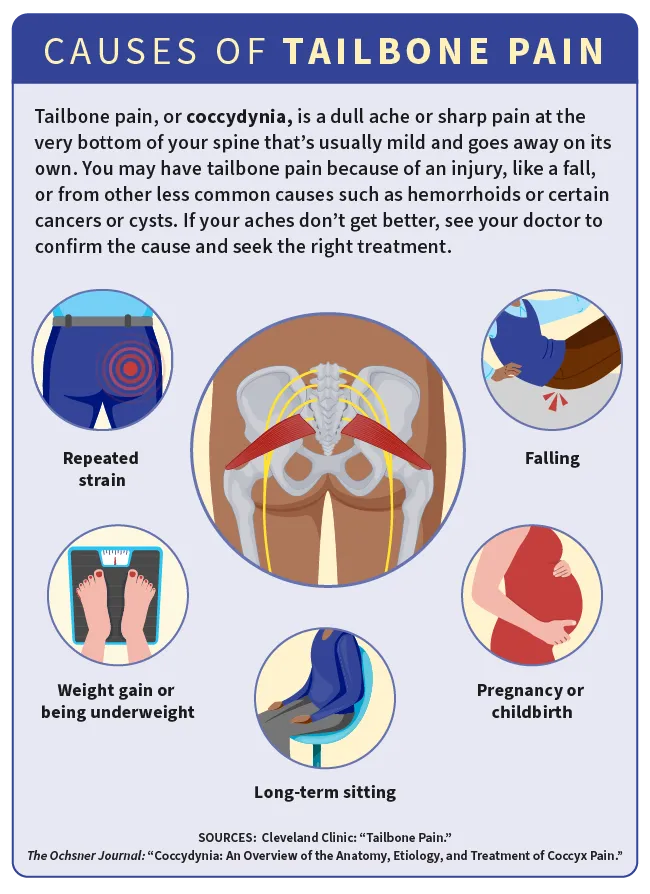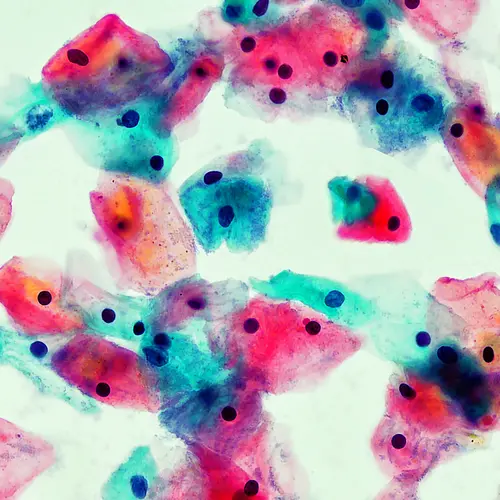What Is Coccydynia?
Coccydynia is the medical term for tailbone pain. Your tailbone, or coccyx, is at the bottom of your spine, and it's made up of three to five fused vertebrae (small bones that support your spine).
It's a common problem, and women and people assigned female at birth are five times more likely than men and people assigned male at birth to develop it.
You may have coccydynia because of an injury, like a fall, or from other causes, like childbirth or sitting too long on a hard surface. Often, tailbone pain is mild and goes away on its own or with treatment, but sometimes, stronger treatment is needed.
Symptoms of Tailbone Pain
Coccydynia can be either a dull ache or a sharp pain. It may get worse when you're sitting or standing for a long time, leaning back while seated, or standing up from a seated position. You may also feel it during a bowel movement or during sex.
Along with tailbone pain, you may also have other symptoms that are related. Depending on the cause of your tailbone pain, these symptoms may include:
- Back pain and sciatica
- Swelling
- Sleep disorders
- Depression and anxiety
- Numbness or tingling in your arms, legs, or groin
- Bowel or bladder problems, such as difficulty going to the bathroom
- A noticeable mass in the tailbone area
If you have any of these symptoms, see your doctor because these symptoms may be signs of other health concerns that need to be addressed.
Tailbone Pain Causes
Tailbone pain is often caused by a noticeable injury, such as falling backward and landing on your tailbone. But several other causes may be behind the pain, and sometimes, the cause is less obvious.

Trauma or injury
Tailbone pain can be caused by an injury, such as falling backward and landing on your tailbone. Such a fall can bruise, dislocate, or break your tailbone.
The pain can also result from injuries from repetitive strain.
These injuries can happen when you're playing sports or engaging in activities like bicycling that require repetitive motion, which can strain the tissues around your tailbone.
Sitting on a hard surface
If you sit on a hard surface, on a narrow surface, or in an uncomfortable position for too long, that can cause minor trauma to the tailbone. Repetitive sitting in these positions can also cause pain.
Pregnancy and childbirth
During pregnancy, your body secretes hormones that soften the area between your tailbone and sacrum, and sometimes, this can stretch the muscles and ligaments around the tailbone so much that it causes pain.
Childbirth is a well-known cause of coccydynia. Ligaments and muscles around the coccyx can get stretched and strained during delivery and cause pain. It's rare, but the bones in your coccyx could break during delivery.
You may still feel pain months after giving birth. Talk to your doctor if it doesn't get better.
Hemorrhoids
If you have hemorrhoids, the tissue that cushions and protects your anal opening gets inflamed and muscles pull on your coccyx. That can cause tailbone pain.
Other signs of hemorrhoids include:
- Bleeding from your bottom
- Burning or pain
- Protrusion or prolapse
- Itching
- Swelling
If it doesn't get better, your doctor may be able to remove the hemorrhoid in their office.
Your weight
Carrying too much weight puts extra pressure on your coccyx when you sit down, which can lead to tailbone pain.
But if you don't have enough fat in your buttocks to cushion the area, your tailbone can rub against the muscles, ligaments, and tendons there and cause inflammation and pain.
Chordoma
Tailbone pain may stem from chordoma, a rare, cancerous tumor that develops in your spine, the base of your skull, or your tailbone. As the mass grows, it can cause pain. Sometimes, a tumor can cause a noticeable mass in the tailbone area.
Prostate cancer
Tailbone pain is sometimes related to prostate cancer, a common cancer in men. As prostate cancer grows, it can lead to bone pain.
Symptoms of prostate cancer include:
- Burning sensation or pain when you pee or ejaculate
- Peeing often, especially at night
- Changes in urine flow
- Erectile dysfunction that comes on suddenly
- Blood in your urine or semen
If you have these symptoms, talk to your doctor.
Vertebral tumor
A vertebral tumor is a type of spinal tumor that affects the bones or vertebrae in your spine. As it grows, it may cause pain in your tailbone. Sometimes, these tumors spread from cancer elsewhere in the body.
Symptoms of a vertebral tumor include:
See a doctor if your tailbone pain gets worse or doesn't go away, you have other symptoms, or you have a history of cancer.
Colorectal cancer
A tumor or cancer in your colon or rectum can cause tailbone pain. Cancer in these areas is called colorectal cancer, or colon or rectal cancer, depending on where the cancer starts. The colon and the rectum make up the large intestine, and the rectum is the last 6 inches of your digestive system.
Symptoms of colorectal cancer include:
- Constipation or diarrhea
- Narrow poop
- Blood in your poop
- Cramps or pain in your pelvis or lower abdomen
- Weight loss
- Fatigue
If you have these symptoms, talk to your doctor.
Pilonidal cyst
A pilonidal cyst is an abnormal pocket in the skin, typically near the tailbone at the top of the buttocks. It usually contains hair and skin debris. When a cyst gets infected, it causes swelling and pain.
If you have a pilonidal cyst, you may notice:
- Pus or blood draining from the skin opening
- Skin redness
- An odor or foul smell from the pus
Whatever the cause of your tailbone pain, if your aches don't get better, see your doctor. The sooner you figure out what's causing the problem, the sooner you can treat it and start to feel better.
How to Relieve Tailbone Pain
Tailbone pain usually goes away on its own in a few weeks or months. In the meantime, you may be able to relieve the pain by adjusting your posture and using home remedies. A few other things you can try for relief include:
Improving your sitting posture. While sitting, you can try leaning forward in your seat. Sitting on a pressure relief cushion, such as one shaped like a wedge, a U, or a donut, can also minimize pain.
Using hot and cold therapy. Home remedies to manage pain include applying heat or ice to the tailbone area, taking a hot bath and taking over-the-counter pain relievers such as acetaminophen and ibuprofen.
Taking a stool softener, sitz bath, or over-the-counter treatments. Stool softeners can help if you have tailbone pain during bowel movements. If hemorrhoids are causing your pain, taking stool softeners, eating more fiber, soaking in a sitz bath, or applying topical over-the-counter medications for hemorrhoids can help.
Stretching. Stretching exercises, including those that stretch the piriformis and iliopsoas, muscles in the buttocks and hips, may help relieve pain. But check with your doctor first to make sure the exercises will be helpful, not harmful, for your tailbone pain.
If these adjustments and home remedies don't relieve the pain, you should see a doctor to determine the cause of the pain. Depending on the cause, you may need further treatment.
Tailbone Pain Diagnosis
A doctor can diagnose the problem by reviewing your medical history, examining you, and performing tests.
A physical exam can help pinpoint the source of the pain. Your doctor may inspect your skin for signs of infection, pilonidal cysts, or hemorrhoids. A rectal exam may be needed to evaluate how mobile the coccyx is.
Your doctor also may order tests. They include:
X-rays can show whether your coccyx has been fractured or dislocated.
A CT scan or MRI can also show fractures, as well as tumors and cancer.
- A bone scan can help determine whether you have inflammation and tumors.
Tailbone Pain Treatment
The treatment your doctor recommends will depend on the cause of your tailbone pain.
If the underlying cause of your coccydynia is cancer, your doctor can recommend the appropriate cancer treatment, such as radiation, chemotherapy, and surgery.
If you have a pilonidal cyst, your doctor may numb the area and make an incision to drain the cyst. If it comes back, you may need surgery to remove it.
If an injury is to blame for your tailbone pain, take time for rest and recovery. If over-the-counter pain relievers don't help or if your pain interferes with your regular activities, your doctor may prescribe pain medication or injections.
Regardless of what's causing your tailbone pain, your doctor may recommend these treatments to manage and alleviate the pain:
An injection of a local anesthetic can relieve pain.
A nerve block, or an injection close to the affected nerves, may also help eliminate pain. Your doctor may inject numbing medications and steroids to reduce inflammation.
Physical therapy can help you stretch your muscles and improve your posture. This may include a physical therapist showing you how to do pelvic floor relaxation techniques.
Massage and manipulation, which your doctor does through your rectum, can help relieve pain from muscle spasms or ligament pain.
Transcutaneous electrical nerve stimulation may alleviate the pain. It delivers electrical impulses through the surface of your skin near the affected muscles or nerves.
Acupuncture, which uses thin needles inserted into the skin, is often used to address pain, and it may also help with coccydynia.
Tailbone Pain Surgery
If other treatments don't work, your doctor may recommend a surgery called coccygectomy. This surgery removes either your entire coccyx or part of it (called total or partial coccygectomy).
Recovery from this surgery may take several months, so it is usually an option only when other more conservative treatments have failed.
Tailbone Pain Prevention
There are several ways you can lessen your risk of tailbone pain and injury.
Sitting
Avoid long periods of sitting, especially on hard surfaces. Maintain good posture when you are sitting down.
- Sit upright.
- Keep your back against the chair.
- Keep your knees level with your hips.
- Keep your feet on the floor.
- Relax your shoulders.
Falling
Reduce your risk of falls.
- Use stair railings.
- Keep your floors and pathways clear.
- Try not to look at your phone while walking.
Physical activity
Be careful during physical activity or sports. Use care while cycling or doing other activities that can put pressure on your tailbone.
Takeaways
See a doctor if your tailbone pain doesn't respond to home remedies. Be mindful of your posture and avoid sitting for too long. Try to reduce your risk of falls.
Tailbone Pain FAQs
What can a doctor do for tailbone pain?
A doctor can determine the cause of your tailbone pain and then recommend treatment, which can range from pain medication to surgery.
What is a nerve pain in the tailbone?
Pain in the tailbone can have multiple causes. Some treatments target the nerves around the coccyx.
Why does my tailbone stick out and hurt?
An injury can dislocate your coccyx (so it may stick out).
How do you massage a sore tailbone?
Massaging the muscles attached to your tailbone might bring some relief. Focus should be on the area near the rectum.

